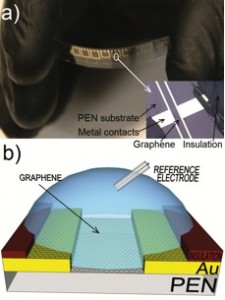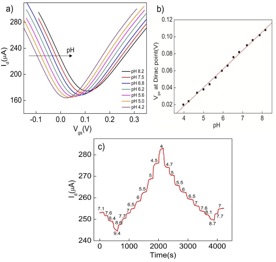Graphene Chemical Sensors on Flexible Substrates
- Category: Circuits & Systems, Electronic Devices, Materials
- Tags: benjamin mailly-giacchetti, graphene, jing kong, tomas palacios
With its all-surface 2D structure combined with very high carrier mobility, graphene is an extremely promising candidate for high sensitivity and low noise chemical sensing [1] [2] . Graphene devices can perform electrical detection for chemical sensing in many applications, e.g.,pH monitoring in electrolytes [3] [4] , measuring blood glucose, and in-vitro recording of the electrical activity of living cells [5] . Integrating graphene on plastic substrates [6] enables fabrication of low-cost, flexible sensors.
Our group has developed the first solution-gated graphene field effect transistor (SGFET) on a polyethylene naphthalate (PEN) substrate. These devices have important advantages with respect to traditional sensors, e.g., intrinsic signal amplification, simple electronic read-out, and straightforward integration with microelectronics. Fabrication of the SGFET starts with the transferring of graphene grown by chemical vapor deposition on the PEN substrate. Metal contacts were previously evaporated on the PEN substrate. Silicone rubber-based insulation was used to protect the metal contacts and wires from any contact with the electrolyte.
As Figure 2.a) shows, the characterization of our devices in a phosphate buffer solution demonstrates good transconductance, around 1 mS.mm-1, and carrier mobility of 300 cm2.V-1.s-1. Transconductance is 5 times smaller than that obtained for graphene on SiO2 which is due to the 10 times rougher surface of PEN compared to SiO2 and also the larger amount of PMMA residues remaining on graphene when transferred onto PEN. The pH measurements have been performed using these devices by recording how the Dirac point shifts with changes in pH, as Figure 2.b) shows. Sensitivity to 22 mV/pH has been demonstrated. In addition, long-term pH monitoring was shown for the first time in these graphene devices, as Figure 2.c) shows. Our on-going work focuses on functionalizing graphene to demonstrate new biosensors for glucose and E. coli detection on plastic substrate.
- Figure 1: a) Optical image of graphene chemical sensor array on plastic substrate. Inset on bottom right corner shows detail . b) Schematic of a graphene-on-PEN solution-gated transistor.
- Figure 2: Transfer characteristics of 50×1000-µm2 graphene-on-PEN SGFET at constant drain-source voltage of Vds=50 mV for different pHs. b) Dirac point shift with pH. c) Drain-source current vs. time data for pHs 9-4.
- M. Dankerl, M. V. Hauf, A. Lippert, L. H. Hess, S. Birner, I. D. Sharp, A. Mahmood, P. Mallet, J. Veuillen, M. Stutzmann, and J. A. Garrido, “Graphene solution-gated field-effect transistor array for sensing applications,” Adv. Funct. Mater., vol. 20, pp. 3117-3124, 2010. [↩]
- L. H. Hess, M. V. Hauf, M. Seifert, F. Speck, T. Seyller, M. Stutzmann, I. D. Sharp, and J. A. Garrido, “High-transconductance graphene solution-gated field effect transistors,” App. Phys. Letters, vol. 99, p. 033503, 2011. [↩]
- Y. Ohno, K. Maehashi, Y. Yamashiro, and K. Matsumoto, “Electrolyte-gated graphene field-effect transistors for detecting pH and protein adsorption,” Nano Lett., vol. 9, pp. 3318-3322, 2009. [↩]
- J. Ristein, W. Zhang, F. Speck, M. Ostler, L. Ley and T. Seyller, “Characteristics of solution gated field effect transistors on the basis of epitaxial graphene on silicon carbide,” J. Phys. D: Appl. Phys., vol. 43, no. 34, p. 345303, 2010. [↩]
- T. Cohen-Karni, Q. Qing, Q. Li, Y. Fang, and C. M. Lieber, “Graphene and nanowire transistors for cellular interfaces and electrical recording,” Nano Lett,, vol. 10, pp. 1098-1102, 2010. [↩]
- S. Bae, H. Kim, Y. Lee, X. Xu, J. S. Park, Y. Zheng, J. Balakrishnan, T. Lei, H. R. Kim, Y. I. Song, Y. J. Kim, K. S. Kim, B. Ozyilmaz, J. H. Ahn, B. H. Hong, and S. Iijima, “Roll-to-roll production of 30-inch graphene films for transparent electrodes,” Naure. Nanotechnology, vol. 5, pp. 574-578, 2010. [↩]

